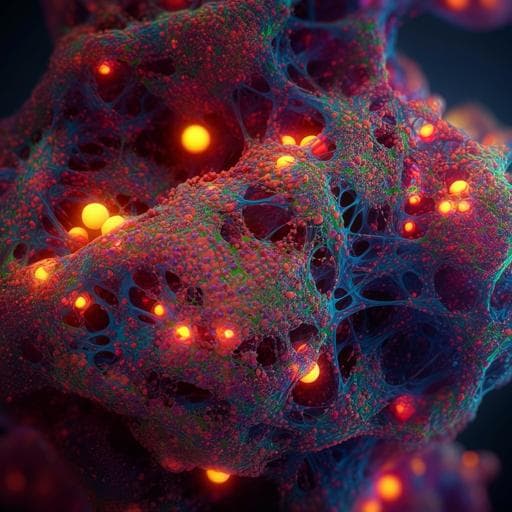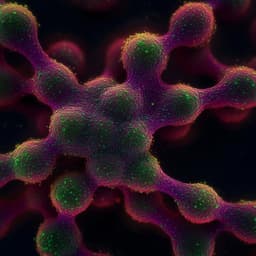
Biology
Mid-infrared chemical imaging of intracellular tau fibrils using fluorescence-guided computational photothermal microscopy
J. Zhao, L. Jiang, et al.
Discover the groundbreaking Fluorescence-guided Bond-Selective Intensity Diffraction Tomography (FBS-IDT), developed by Jian Zhao and colleagues, which enables detailed chemical-specific imaging of tau fibrils in their native cellular environment, revealing intriguing links between lipid accumulation and tau aggregation.
~3 min • Beginner • English
Introduction
The study addresses a key challenge in Alzheimer’s disease and related tauopathies: non-invasive extraction of molecular structural information from intracellular tau aggregates within their native cellular environment. Tau aggregates are intracellular, structurally diverse at the atomic level across isoforms and conformers, and predominantly composed of β-sheet secondary structures. Existing methods either require purified, non-native samples, lack spatial resolution or site specificity, or cannot quantify secondary protein structures in situ. There is a need for cost-effective, high-resolution, 3D, chemically specific imaging that is sensitive to β-sheet content and compatible with intracellular fluid environments. The work proposes Fluorescence-guided Bond-Selective Intensity Diffraction Tomography (FBS-IDT) to overcome these limitations, enabling volumetric chemical imaging, site-specific mid-IR spectroscopy, and 3D visualization of protein secondary structure, and to explore potential lipid–tau aggregate correlations.
Literature Review
Multiple techniques have been used to study amyloid aggregates and tau: structural biology methods (X-ray crystallography, SAXS, NMR, Cryo-EM) resolve atomic structures but require purified samples, complex preparation, and expensive instrumentation, hindering direct intracellular analysis. Circular Dichroism provides rapid secondary structure estimates in dilute solutions but with limited predictive accuracy for β-sheets and lacks site specificity. PET enables brain-wide imaging but with low spatial resolution (~2 mm). Fluorescence imaging excels at high-resolution intracellular localization but does not quantify secondary structures. Raman-based imaging (including stimulated Raman scattering and tip-enhanced Raman) has probed tau fibrils and other aggregates but suffers from very weak scattering cross-sections (~10^−30 to 10^−28 cm^2), requiring point scanning with high power and risking photodamage; amide band signals are weak and β-sheet discrimination (parallel vs anti-parallel) is ambiguous. IR-based approaches benefit from much larger absorption cross-sections (~10^−18 cm^2), high sensitivity to bond strength changes and β-sheet content, and improved accuracy without tight focusing. Conventional IR spectroscopy lacks spatial resolution and site specificity; AFM-IR improves spatial resolution but is limited to 2D and requires dry samples, potentially altering native structures. Emerging mid-IR photothermal (MIP/OPTIR) microscopy inherits IR advantages and offers visible-diffraction-limited hyperspectral 2D/3D imaging. Prior MIP studies characterized amyloid aggregates in 2D and extracted spectra but did not resolve 3D heterogeneity. 3D MIP combined with optical diffraction tomography or intensity diffraction tomography has been shown for normal proteins but not for intracellular amyloid aggregates, and weak amyloid signals are often overwhelmed by background without guidance.
Methodology
The proposed Fluorescence-guided Bond-Selective Intensity Diffraction Tomography (FBS-IDT) integrates a 3D mid-IR photothermal pump–probe imaging modality with a 2D single-photon fluorescence guide. Principle: A tunable pulsed mid-IR pump (QCL) excites molecular vibrations in the fingerprint region, inducing transient, chemical-specific temperature rises, thermal expansion, and local refractive index (RI) changes. Synchronously, pulsed visible probe beams (~450 nm) from a custom ring array (16 low-cost diode lasers) illuminate the sample sequentially at oblique angles matched to the objective NA. The system records intensity images per illumination, capturing linearized cross-interference mapped to shells on the Ewald sphere in 3D Fourier space under the first Born approximation. Slice-wise 3D RI reconstruction is performed via intensity diffraction tomography (IDT) deconvolution by synthesizing data from all 16 illuminations and inverse transforming to obtain volumetric RI maps. Hot/Cold subtraction: The mid-IR pump is modulated (≈50 Hz) to alternate between “Hot” (pump on) and “Cold” (pump off) states while both pump and probe operate in pulse modes (~10 kHz, ~1 μs pulses) synchronized with a 100 Hz CMOS camera. For each mid-IR wavenumber, 3D RI maps are reconstructed for Hot and Cold states and subtracted to yield chemical-specific 3D RI variation maps. Tuning across the mid-IR fingerprint band produces 4D hyperspectral volumes (x,y,z, wavenumber), enabling site-specific depth-resolved spectra. Fluorescence guidance: With pump/probe off, a 488 nm excitation illuminates GFP-labeled samples; fluorescence images acquired on the same camera delineate amyloid aggregate regions to guide spectral extraction and spatial segmentation, mitigating background protein signals. Secondary structure analysis: Using fluorescence-guided ROIs, depth-resolved mid-IR spectra are extracted from the amide I region and deconvolved to quantify secondary structure components (e.g., α-helix, β-sheet) and their spectral positions and areas. 3D visualization of β-sheets is realized via spectral ratio mapping between two selected wavenumbers corresponding to secondary structure features. Instrumentation: Built on a brightfield transmission microscope (objective, tube lens, CMOS). The mid-IR pump is loosely focused onto the sample via an off-axis gold parabolic mirror, producing a ≈63 μm FWHM spot suitable for widefield single-cell imaging. The illumination angles of the 16 probe beams maximize spatial frequency coverage through synthetic aperture principles, enabling visible-band diffraction-limited resolution (~350 nm lateral, ~1.1 μm axial). The acquisition speed for 3D chemical quantitative phase imaging reaches ~6 Hz. Sample preparation for 3D chemical imaging demonstration used fixed human epithelial Tau RD P301S FRET Biosensor cells, with experimental samples seeded with tau fibril fractions and controls unseeded; samples were washed and immersed in D2O-based PBS between 0.2 mm CaF2 windows to minimize water spectral overlap in the amide I band. Outputs: (1) label-free 3D chemical maps (e.g., amide I protein, lipid bands), (2) fluorescence-guided, site-specific, depth-resolved mid-IR spectra, and (3) 3D visualizations of secondary structure distributions (notably β-sheets).
Key Findings
- Introduces FBS-IDT, a cost-effective, table-top computational mid-IR photothermal microscope integrated with fluorescence guidance, enabling chemical-specific volumetric imaging and site-specific 3D mid-IR fingerprint spectroscopy of intracellular tau fibrils in their native fluid environment.
- Demonstrates label-free hyperspectral 3D chemical imaging of fixed human epithelial cells (Tau RD P301S FRET Biosensor cells) with and without seeded tau fibrils, revealing cellular features across depth in protein (amide I) and lipid bands and minimal changes in the cell-silent window (1800–2700 cm^-1).
- Uses fluorescence guidance (GFP) to differentiate amyloid aggregates from background proteins, enabling extraction of depth-resolved, site-specific mid-IR spectra from intracellular tau fibrils.
- Performs amide I deconvolution to quantify secondary structure components, and achieves 3D visualization of β-sheet distributions within intracellular tau aggregates via spectral ratio mapping.
- Suggests a potential correlation between lipid accumulation and tau aggregate formation at the single-cell level by co-imaging lipids and tau aggregates in 3D.
- Technical performance: visible-band diffraction-limited resolution (~350 nm lateral, ~1.1 μm axial), widefield mid-IR pump spot (~63 μm FWHM), synchronized pulsed pump–probe detection (~10 kHz, ~1 μs pulses), Hot/Cold modulation at 50 Hz with a 100 Hz camera, and ~6 Hz 3D chemical imaging speed.
- Overcomes limitations of prior methods by providing non-invasive, high-resolution, volumetric chemical imaging and secondary structure analysis of intracellular amyloid aggregates, which previously lacked 3D characterization and site specificity.
Discussion
FBS-IDT addresses the need for non-invasive, in situ characterization of intracellular tau aggregates by combining mid-IR photothermal sensitivity to chemical bonds and secondary structure with fluorescence-based spatial guidance. The method resolves 3D morphological and chemical heterogeneities of amyloid aggregates within the native fluid environment and enables depth-resolved, site-specific spectral analysis, specifically in the amide I region that is highly sensitive to β-sheet content. By co-imaging proteins and lipids, it facilitates investigation of the interplay between lipid accumulation and tau aggregation, offering insights into cellular mechanisms implicated in neurodegeneration. Compared to structural biology techniques requiring purified samples, PET’s low spatial resolution, fluorescence imaging’s lack of structural quantitation, and Raman’s weak signals and potential photodamage, FBS-IDT delivers a cost-effective, high-resolution, volumetric, and chemically specific imaging platform. The obtained 3D β-sheet visualizations and depth-resolved spectra directly support the central hypothesis that secondary structure content within intracellular tau fibrils can be quantified and mapped, providing an enabling tool for studying tauopathies and evaluating therapeutics.
Conclusion
The study introduces and validates Fluorescence-guided Bond-Selective Intensity Diffraction Tomography (FBS-IDT), a simple, cost-effective microscope that achieves chemical-specific 3D imaging and site-specific mid-IR spectroscopic analysis of intracellular tau fibrils under native-like fluid conditions. It demonstrates label-free volumetric imaging of proteins and lipids, fluorescence-guided extraction of depth-resolved amide I spectra, and 3D visualization of β-sheet distributions, addressing long-standing limitations in intracellular amyloid characterization. These capabilities open avenues to probe the heterogeneity of tau aggregates and their interactions with lipids at single-cell resolution. Potential future directions include extending to live-cell imaging, applying to diverse amyloid species and proteinopathies, improving throughput and sensitivity, and integrating advanced spectral unmixing for more comprehensive secondary structure mapping.
Limitations
Related Publications
Explore these studies to deepen your understanding of the subject.







